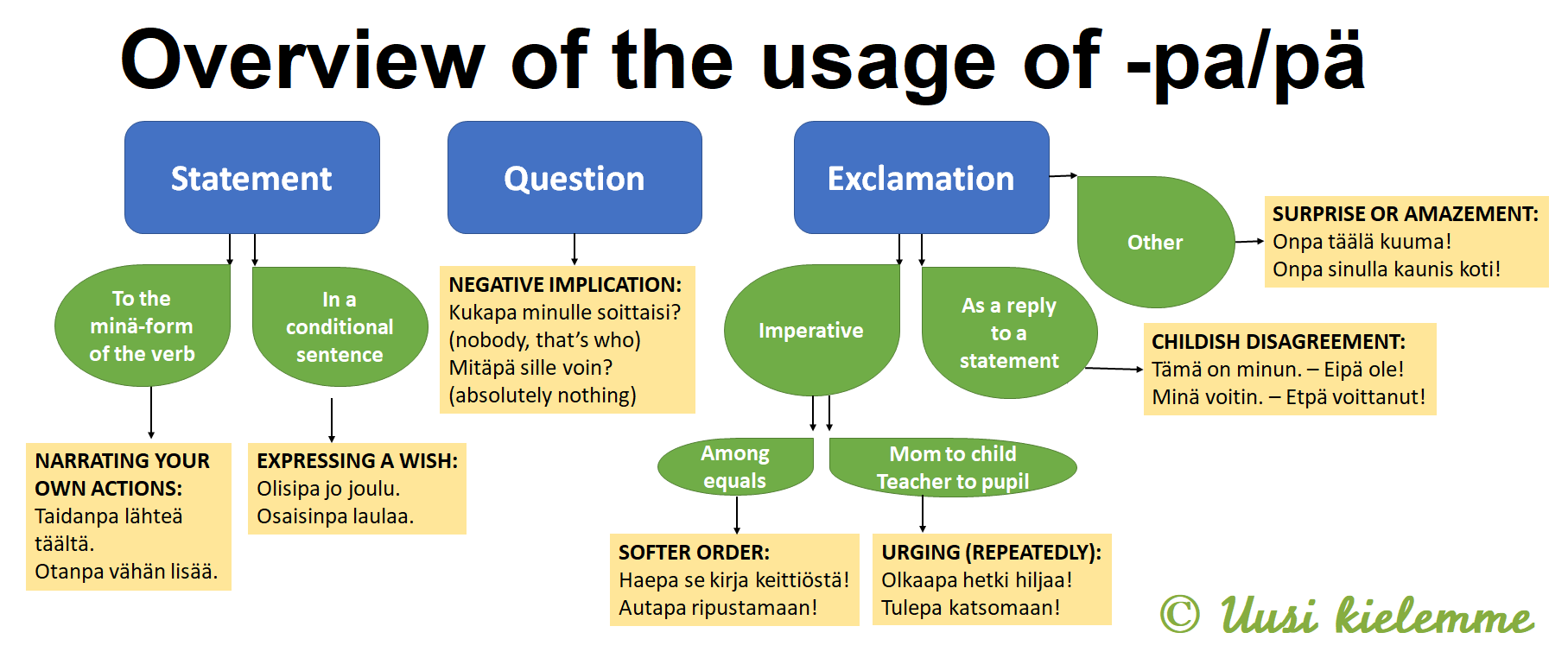-Pa/Pä Liitepartikkeli Clitic – Onpa vaikeaa!
The suffix -pa/pä is used in many different situations in Finnish. You add this clitic (liitepartikkeli) to the end of a word to give an extra nuance to the general meaning of the sentence. It’s how you can make a sentence carry a little extra meaning than what the words say.
For example, the sentence Onpa hyvää kahvia! “Wow, this is great coffee!” is stronger than just stating Kahvi on hyvää. “The coffee is good”.
Below, you can find out when to use the suffix -pa/pä. This article is part of a larger series on clitics in Finnish. I will be adding more links to this article as I work my way through all of them.
- The syntax of -pa/pä
- The usage of -pa/pä
- Expressing surprise or amazement
- Expressing a wish
- Giving a softer order
- Exclaiming in disagreement
- Expressing negative implication
- Narrating your own actions
- Common uses in colloquial situations
- Overview of the usage
- Pronunciation of -pa/pä
- Assimilation of -np- into -mp-
- Syntactic gemination -ppa
1. The syntax of -pa/pä
Whether we use -pa or -pä depends on vowel harmony (e.g. sääripä vs. saaripa).
The suffix -pa/pä will be added to the first word of a sentence. This word can be any wordtype whatsoever: a noun, verb or adverb. We can change the word order of the sentence in order to stress a different word. There are certain limitations to which word orders sound natural, but it’s hard to pinpoint the specifics of this.
| Finnish | English |
|---|---|
| Onpa sinulla pitkä tukka! | Wow you have long hair! |
| Avaapa ovi! | Open that door! |
| Olisipa jo perjantai. | If only it was Friday already. |
2. The Usage of -pa/pä
2.1. Expressing surprise or amazement
The liitepartikkeli -pa/pä can be used to express surprise or amazement about something. You will most commonly find this clitic added to the verb olla at the beginning of a sentence: onpa. You can, however, attach it to all types of words.
| Finnish | English |
|---|---|
| Onpa söpö vauva! | Wow, such a cute baby! |
| Onpa täällä kylmä! | Wow, it’s cold here! |
| Oletpa sinä kasvanut! | Wow, you’ve grown! |
| Sinäpä olet laihtunut! | Wow, you’ve lost weight! |
| Olipa töykeä tarjoilija! | Wow, that was a rude waiter! |
| Kylläpä aika rientää! | Wow, time really flies! |
| Tulitpa nopeasti! | Wow, you came quickly! |
| Jopa on iso kala! | Wow, that’s one big fish! |
| Jopa oli hieno elokuva! | Wow, that was one great movie! |
This is one use of this clitic that you should learn early on, because this is by far the most common way to express emphatic surprise in Finnish.
2.2. Expressing a wish
In combination with the conditional, you can express that you wish something with -pa/pä.
| Finnish | English |
|---|---|
| Olisitpa täällä. | If only you were here. |
| Jospa ei sataisi. | If only it didn’t rain. |
| Osaisinpa laulaa. | If only I could sing. |
| Olisipa jo kesä. | If only it was summer already. |
2.3. Giving a softer order
You can also add the suffix -pa/pä to an imperative form. It makes orders less absolute. If you remember, the clitic -han/hän could also be added to imperatives, which made them more into suggestions. The clitic -pa/pä is similar to that. It makes you sound less bossy.
Among “equals”, adding -pa/pä makes an order softer. However, you’re more likely to hear it situations of inequality like mother/child, boss/employee, teacher/pupil. In those situations, the idea in the background is that the thing the higher person is requesting is easy to complete. In the family setting, it’s most commonly used when trying to make a child do something, when they need more than one reminder to complete the task. It can have a sense of impending doom added to it: “…or else!” The person who’s lower in status won’t typically use -pa/pä when addressing the higher person.
| Finnish | English |
|---|---|
| Haepa se kirja. | Go get that book, will you. |
| Tulepa sisään nyt. | Come in now, will you. |
| Olkaapa hetki hiljaa! | Be quiet for a second, will you! |
| Menkääpä katsomaan! | Go look, will you! |
| Lähetäpä hänelle viesti! | Send him a message, will you! |
2.4. Exclaiming in disagreement
We can use both –pa/pä and –han/hän to exclaim in disagreement. Of the two, -han/hän is the more grown-up, definitive disagreement. When you’re disagreeing using -pa/pä it often has a little bit of a childish vibe to it.
| Finnish | English |
|---|---|
| – Minä voitin! | – I won! |
| – Etpä voittanut! | – No you didn’t! |
| – Tämä on minun. | – This is mine. |
| – Eipä ole, se on minun! | – No it’s not, it’s mine! |
| – Älä tule tänne! | – Don’t come here! |
| – Tulenpas! | – Oh yes, I will come! |
2.5. Expressing negative implication
The suffix -pa/pä can also be attached to the end of a question word in sentences that are mainly meant to be rhetorical. The function of the clitic in these sentences is the express that the speaker considers the thing in question to be impossible or pointless. It’s most commonly used with the conditional form of the verb, but not exclusively.
| Finnish | English |
|---|---|
| Kukapa minulle soittaisi? | After all, who would call me (nobody would)? |
| Mitäpä sanottavaa meillä olisi? | After all, what would we have to say (nothing)? |
| Kukapa minua uskoisi? | Who would believe me (nobody would)? |
2.6. Narrating your own actions
When the suffix -pa/pä is added to the present tense’s first person singular (minä-form), it can mean that you’re kind of narrating your own actions, saying out loud what you’re going to be doing yourself. This can often be interpreted as the speaker telling us of a decision they just made, or being self-conscious about what they’re about to do.
| Finnish | English |
|---|---|
| Taidanpa lähteä täältä. | I will be leaving here, I think. |
| Otanpa varmuuden vuoksi vielä tämän. | I’ll just take this to be sure, won’t I. |
| Vienpä mummolle metsämansikoita. | How about I bring stawberries to grandma. |
| Lähdenpä tästä baariin. | How about I go to a bar from here. |
| Kuule, kerronpa vielä yhden jutun. | Listen, let me tell you one more thing. |
2.7. Common uses of -pa/pä in colloquial Finnish
| Finnish | English |
|---|---|
| Olipa kerran… | Once upon a time… |
| Kiitos! – Eipä kestä! | Thanks! – You’re welcome! |
| Kiitos! – Eipä mitään! | Thanks! – No problem! |
| Eipä ihme! | No wonder! |
| Eipä tässä sitten muuta. | Alright, then. That’s all then. |
| ehkäpä | possibly |
| tuskinpa (in a sentence) | hardly |
| Tuskinpa! | Doubt it! As if! Fat chance! |
| niinpä | read more here |
| Elämä on. – Niinpä niin. | That’s life. – Yes indeed. |
| joopa joo | usually sarcastic “sure” |
| heipä hei | both “hi” and “bye”, friendly |
| tervepä terve | “hi”, colloquial |
3. Pronunciation of -pa/pä
The suffix -pa/pä is interesting from a practical point of view, because it’s so commonly used to add more nuance to your sentences. In addition, however, it’s also interesting from a more linguistic point of view. This clitic is in fact the perfect example to show some phonetic changes that are either typical for Finnish or true for languages in general.
For both of the phonetic phenomena mentioned below it’s important to note that while these appear in spoken language, they are not part of any dialect or slang. They’re regular occurrences in any case where two sounds coincide with eachother.
3.1. Assimilation of -np- into -mp-
Assimilation is what we call the process when two speech sounds end up next to each other and influence the pronounciation of either (or both) of the sounds. This is common in many languages, especially with consonants that are pronounced in different parts of your mouth (e.g. m-/-p, or n-/-k). I will go into more detail in another article, but for now, let’s look at what happens with –pa/pä!
When adding -pa/pä to a word that ends in an -n, we will notice assimilation in the way the -n is pronounced: it will change into more of an m-sound. This happens because both -m and -p are consonants you pronounce with your lips (labial consonants). In contrast, the n-sound is produced just behind your teeth (alveolar consonant).
While we still spell it -np-, this combination of sounds will be pronounced more like -mp-.
| Written | Spoken |
|---|---|
| Onpa sinulla terävät hampaat! | Ompa sinulla terävät hampaat! |
| Osaisinpa laulaa. | Osaisimpa laulaa. |
| Taidanpa lähteä täältä. | Taidampa lähteä täältä. |
3.2. Syntactic gemination -ppa
Another super interesting phonetical phenomenon are the situations where the -p- in -pa/pä gets doubled in when spoken (e.g. tulepa → tuleppa), which is especially common with the imperative form of verbs. This topic definitely deserves an article on its own, where we can dive deeper into phonological terms like x-morphemes and word-initial gemination.
| Written | Spoken |
|---|---|
| Avaapa ikkuna! | Avaappa ikkuna! |
| Menepä ulos! | Meneppä ulos! |
| Haepa isäsi! | Haeppa isäsi! |
Read more elsewhere about -pa/pä
I’ve glanced over some details and peculiarities of this issue in the article. Further articles might dive deeper into these details. For now, you can read more from the following sources:
- KOTUS: Liitteet -pa/-pä ja -s: tulepas tänne
- Kielikello: Niistäpä niistä, sävypartikkeleista
- Seminaarityö: Liitepartikkelit



